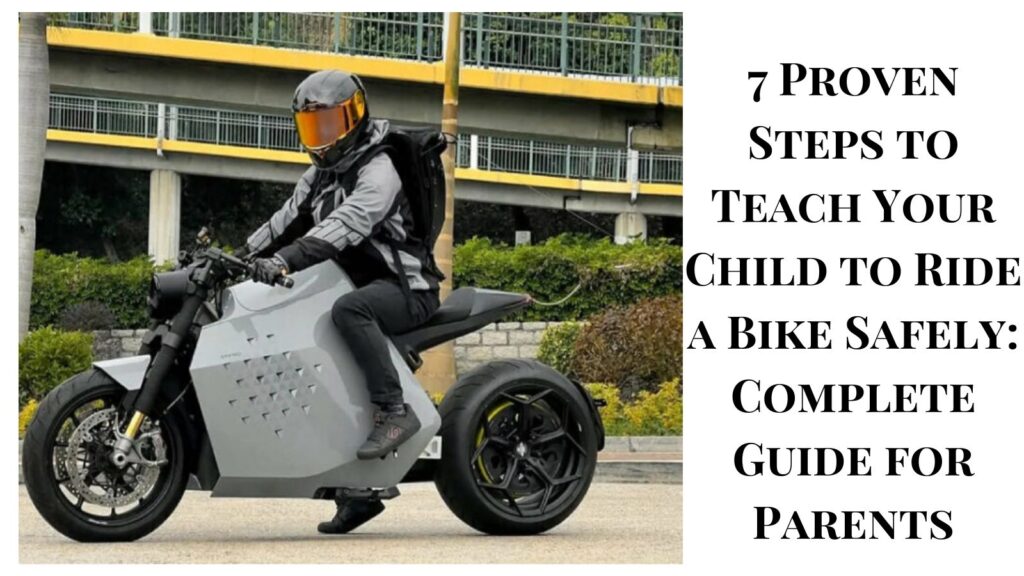Teaching a child to ride a bike is an exciting milestone for both parents and children. It’s a mix of joy, patience, and determination as your child gains new skills and confidence. However, it’s crucial to ensure that the process is done safely, with a focus on proper guidance and the right equipment. In this comprehensive guide, we will explore step-by-step how to teach your child to ride a bike, how to overcome fears, the necessary safety measures, and how to choose the perfect bike for your child. Let’s dive in!

- Preparing Your Child and Setting the Right Expectations
Before you even consider jumping on a bike, it’s essential to assess your child’s readiness. Here are some key factors to consider:
Age: The average age for learning to ride a bike varies between 3 and 6 years. Children younger than this may not have the physical strength or coordination to master pedaling.
Physical Maturity: Ensure your child can balance, pedal, and steer before starting the training. It’s also helpful to check if your child has already developed the ability to sit still for short periods.
Mental Readiness: Some children might be excited to ride, while others may be scared. It’s important to gauge your child’s emotional readiness. Try not to rush them; learning at their pace will make it easier for both you and your child.
- Choosing the Right Bike Size for Your Child
The bike size plays a crucial role in helping your child learn to ride safely and comfortably. An incorrectly sized bike can lead to frustration or even injuries. Here’s how to choose the correct bike for your child based on their age and height:
12-inch wheels: Ideal for children aged 2 to 3 years, with a height of 35 to 40 cm.
16-inch wheels: Suitable for children aged 4 to 5 years, with a height of 40 to 55 cm.
18-inch wheels: Best for children aged 5 to 6 years, with a height of 50 to 60 cm.
20-inch wheels: Designed for children aged 6 to 8 years, with a height of 55 to 63 cm.
24-inch wheels: Ideal for children aged 7 to 11 years, with a height of 60 to 70 cm.
A well-fitting bike allows your child to reach the ground comfortably with their feet, making it easier to balance.
- Essential Safety Measures for Bike Riding
Safety should be a priority in every step of the learning process. Here are some essential safety tips to keep your child safe while learning to ride a bike:
Helmets: Always make sure your child wears a properly fitted helmet. The helmet should cover the forehead, with the straps snug but not tight. A two-finger gap between the chin and the helmet is ideal. Never allow your child to ride without a helmet.
Knee and Elbow Pads: Protecting the elbows and knees can prevent serious injuries if your child falls. Be sure to use well-fitted knee and elbow pads.
Proper Footwear: Sneakers are the best choice for riding. Avoid sandals or open-toed shoes, as they may cause foot injuries.
Bike Maintenance: Regularly check the bike’s condition, including tire pressure, brakes, chain, and gears. An old or poorly maintained bike could be dangerous during practice.
Location: Practice in a safe, open area, such as an empty parking lot or a park with no traffic. Avoid areas with lots of pedestrians or cars during practice sessions.
- How to Teach Your Child to Ride a Bike: Step-by-Step Guide
Now, it’s time to begin the actual learning process. The key is to be patient and allow your child to progress at their own pace. Here are the steps you should follow:
Step 1: Start with the Basics: Getting Comfortable on the Bike
Before attempting to ride, your child should get comfortable with sitting on the bike and using the pedals. Help them practice balancing by:
Having your child sit on the bike with their feet on the ground and getting used to the feel of the seat.
Encourage them to push off with their feet while sitting on the bike and glide for a few seconds. This will help them develop balance before moving to pedaling.
Step 2: Pedal and Glide
Once your child is comfortable gliding, it’s time to introduce pedaling. You can assist by gently holding their back or shoulders while they start pedaling. Remind them to look ahead and keep their body relaxed.
Step 3: Introduce Braking
Braking is one of the most important skills for a child to learn. Teach your child how to slow down and stop safely by applying the brakes gradually. Always emphasize the importance of not slamming the brakes suddenly, as this could cause the bike to skid.
Step 4: Increase Speed Gradually
As your child gains confidence, allow them to pedal faster. Keep your hand on the bike to provide support if needed. As they get better, gradually reduce the amount of assistance you provide.
Step 5: Practice Turning
Once your child is comfortable with balancing and pedaling, it’s time to practice turning. Teach them how to steer the bike and make turns by leaning slightly in the direction they want to go. Practice turning both left and right in an open area.
Step 6: Ride Independently
The final step is to let your child ride independently. Stay nearby to offer support in case they fall, but give them the freedom to practice on their own.
- Overcoming Fear and Building Confidence
Many children experience fear when learning to ride a bike, but it’s important to reassure them. Here are some tips to help your child overcome fear:
Be Patient: Don’t force your child to ride before they’re ready. Give them time to get comfortable and build confidence.
Encourage Small Wins: Celebrate small milestones, such as balancing for a few seconds or riding in a straight line.
Stay Calm and Supportive: Avoid getting angry or frustrated if your child struggles. Offer encouragement and remain calm, even when they fall or make mistakes.
Positive Reinforcement: Praise their efforts, not just their success. Positive reinforcement will help them feel confident and motivated to keep trying.
- Teach Traffic Safety and Basic Rules
Once your child has mastered basic bike riding skills, it’s time to teach them about traffic rules. This is essential for their safety and helps them become responsible bike riders. Key rules to cover include:
Traffic Signs: Teach your child about stop signs, yield signs, and traffic lights.
Proper Lane Positioning: Teach them to stay to the right side of the road and avoid riding in the middle.
Using Hand Signals: Show them how to use hand signals when turning, which helps ensure they are visible to other riders and vehicles.
Awareness of Vehicles: Explain the importance of looking around and checking for cars or other obstacles while riding.
- Practice Makes Perfect
Riding a bike is a skill that improves with practice. Try to practice regularly, but always take breaks to avoid fatigue. Keep sessions fun and engaging to maintain your child’s interest.
Frequently Asked Questions (FAQs)
What age is best to teach a child to ride a bike?
The ideal age to start teaching a child to ride a bike is between 3 and 6 years. However, some children may be ready earlier or later depending on their physical and emotional development.
How do I know if the bike fits my child?
To ensure the bike fits, your child should be able to touch the ground with their feet while sitting on the seat. The handlebars should be at a comfortable height, and the pedals should be easy to reach.
How can I prevent my child from being scared of riding a bike?
Encourage your child, start in a calm and open space, and take the process step-by-step. Avoid rushing them and celebrate small victories to build their confidence.
What type of bike should I choose for my child?
Choose a bike with wheels that match your child’s height and abilities. Balance bikes or bikes with training wheels are great for younger kids, while bigger bikes are suitable for older children.
How can I teach my child to brake safely?
Show your child how to apply the brakes gently, and practice stopping in a controlled manner. Make sure they know not to brake suddenly to avoid falling.
Conclusion
Teaching your child to ride a bike is an incredibly rewarding experience that strengthens your bond and teaches them important life skills. By following the steps outlined above, prioritizing safety, and being patient, you can help your child build confidence and become a skilled bike rider. Remember that every child learns at their own pace, and with persistence and support, your child will soon be riding on their own with ease!
MUST READ:
Dirt Bike Protective gear for kids? – AuttoMotoGeek
Dirt Bike Protective gear for kids? – AuttoMotoGeek





